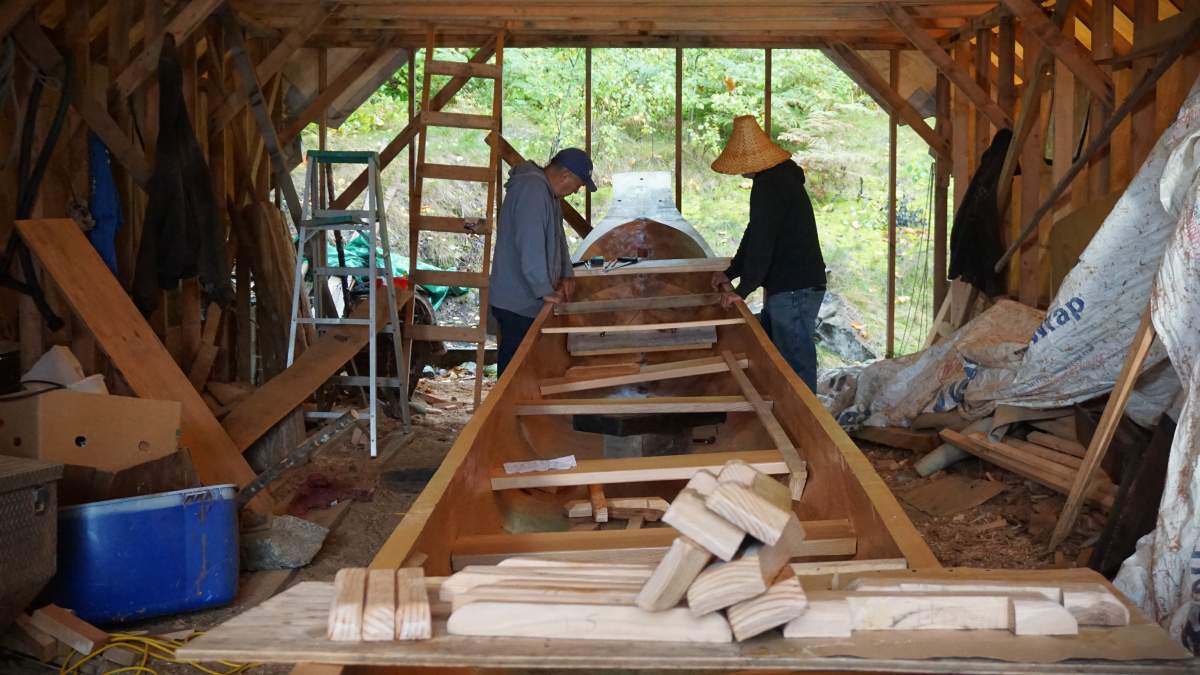Throughout the year, Global News has highlighted culture and community-driven stories from Indigenous people across the province.

There were major headlines like Tseshaht First Nation announcing findings into its residential school investigation and λugʷaləs becoming the first baby in B.C. to have his Indigenous name on his birth certificate as well as stories that taught us about the importance of a community-built powwow arbour and an Indigenous comedy duo that formed out of a community’s need for laughter.
Community-driven stories are stories that are told with distinctive communities — in this case Indigenous — and are shaped by culture and history through the social process of storytelling. They often take more time, require consultation and relationship-building.
We’ve collected a few of our favourite community-driven stories here as we reflect on 2023 and look forward to sharing more of your stories in 2024.
Should non-Indigenous people buy, wear Indigenous art? Creators say it depends
In the era of reconciliation, more conversations are being had about what is — and isn’t — an acceptable way for non-Indigenous people to show support for Indigenous artists.
Indigenous art is increasingly being copied, reproduced or stolen and with questions around authenticity rising, many non-Indigenous folks have begun to tread carefully and question where to buy or whether they should be buying.
“My response is always ‘Absolutely, it’s OK,’” said Nicole Geary a registered member of Sahtu Dene and Métis of Norman Wells and the artist behind Beaded Legacy. “It (shows) Indigenous culture is alive, it is thriving and it is all around us; it’s a big statement to our survival and resiliency.”

‘The last one’: The life of Haisla collector, carver and hereditary chief Sammy Robinson
Over the decades, Haisla Nation’s Sammy Robinson’s carving shop has been a draw for tourists, art collectors, school groups, and more.
“Carving means a lot to me, to people my age,” he told Global News.
While a Sammy Robinson carving can now fetch tens of thousands of dollars, no price tag can be placed on what Robinson’s artwork represents. Each piece is laden with stories, from the one physically etched into it, to the survival of an ancient craft that colonial Canada tried to snuff out.
Global News’ Elizabeth McSheffrey sat down with Robinson for an exclusive interview.

‘Our matriarch’: B.C. lacrosse legend honoured ahead of North American Indigenous Games

Get daily National news
Team BC U19 women’s box lacrosse team worked hard preparing for the North American Indigenous Games (NAIG) held in Halifax this past summer, coming away from the games with gold and they did it for Cherlyn Billy.
The players’ motto this past summer was “This one’s for CB,” in honour of Billy, their former manager and a legend in the lacrosse world for her effort to grow women’s lacrosse at NAIG and across Indigenous communities. She died unexpectedly in December.
“We’re really wanting to do this one for her cause without her, none of this would’ve been possible,” said assistant coach Alivia Ungaro.
“She did so much for the girls when it came to fundraising (and) advocacy. She truly was our matriarch, wanting to get our name out there and show what we can do.”

‘My hands went into this’: Community makes regalia ahead of powwow
Powwow regalia is expensive. A handmade jingle dress, grass dance outfit or fancy shawl can run you hundreds — if not thousands — of dollars, making this aspect of culture difficult for many to connect with or force most to break the bank.
It’s a gap the Vancouver Aboriginal Health Society (VAHS) set out to address ahead of its first annual Father’s Day powwow. And for months leading up to the powwow they hosted sewing and regalia-making classes to make sure everyone was ready.
“We have a lot of families that were interested in dancing and making regalia but the cost of living is just so expensive that it’s not in their price range,” said Rosemary Stager-Wallace, executive director of VAHS. “We really wanted to give people low-barrier access to their culture.”

‘A powerful statement of pride’: Basketball is a legacy for this First Nations family
Brittany Williams won MVP at the All Native Basketball Tournament when she was 22. And she did it with her two-year-old daughter Kionah, and mother Karen White watching from the stands.
She grew up with a hoop in the driveway, and basketball in her blood. “I had no clue what my mom was a part of,” said Brittany. “And once I started getting out there people kept saying ‘You’re Karen White’s daughter, we see why you’re doing so well.’”
Now, with Kionah – a third generation is taking up the family legacy.

‘Way of life’: First ocean-going canoe in decades being built in Haisla Nation
Canada tried to extinguish many traditional skills and practices of First Nations people. Two members of the Haisla Nation want to breathe new life into one of them.
“I’m practicing, working my way up to build my first full-length canoe,” says Kah Kah neese Baba’o Tomé Cordeiro.
It’s a labour of love and importance in a First Nation that, like many across Canada, has had to work too hard to pass on its traditions through the crippling impacts of colonization.
“Canoes used to be the backbone of the Haisla and that’s partially probably why we’re still here,” Cordeiro explains.

‘Koeye feels like home’: Heiltsuk land-based camp immerses youth in language and culture
Koeye Camp is a land-based language and culture program for Heiltsuk youth located south of Namu, B.C. Run by Qqs Projects Society, the camp has been happening every summer — except during COVID-19 — for the past 25 years along the Koeye River.
Allie Elluk grew up at Koeye Camp. Her mom used to work in the kitchen at the old lodge and she spent summers there before becoming a camper. “I went out every year just because it was so much fun and I was able to be myself, learn my culture, my language and find that piece of my identity,” she said.
The camp has made a difference in the lives of hundreds of Heiltsuk youth since its inception.

Looking for more Indigenous news? Find our stories here.
- Surrey police say home possibly targeted in 3 separate shootings
- Some B.C. highways in North Coast reopen after closures due to flooding
- B.C. paramedics union warns of potential job action as bargaining talks break down
- ‘He hunted them’: Family launches petition to keep B.C. mass murderer behind bars








Comments